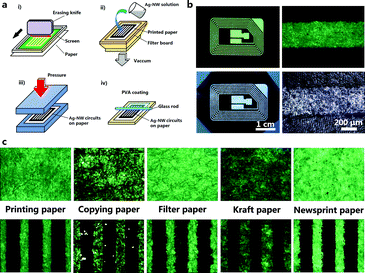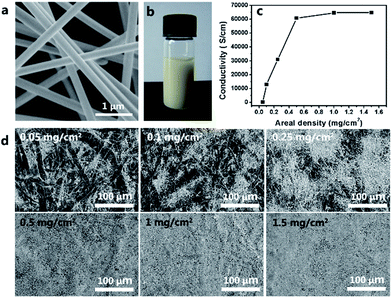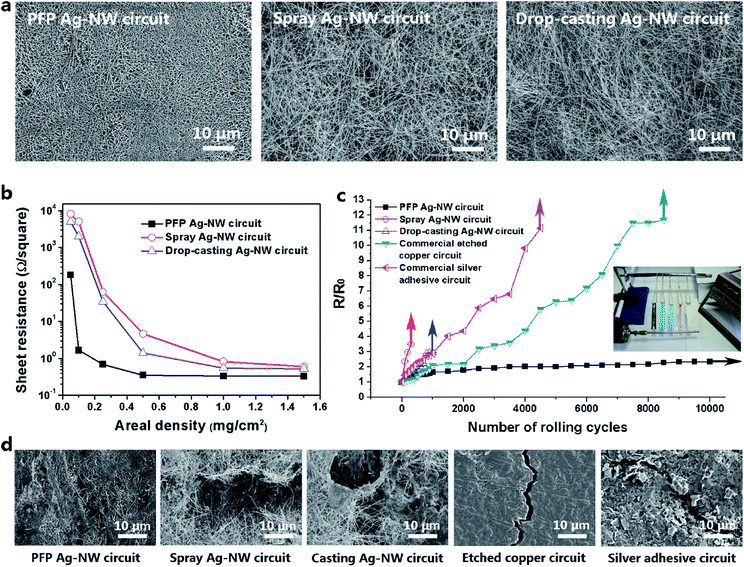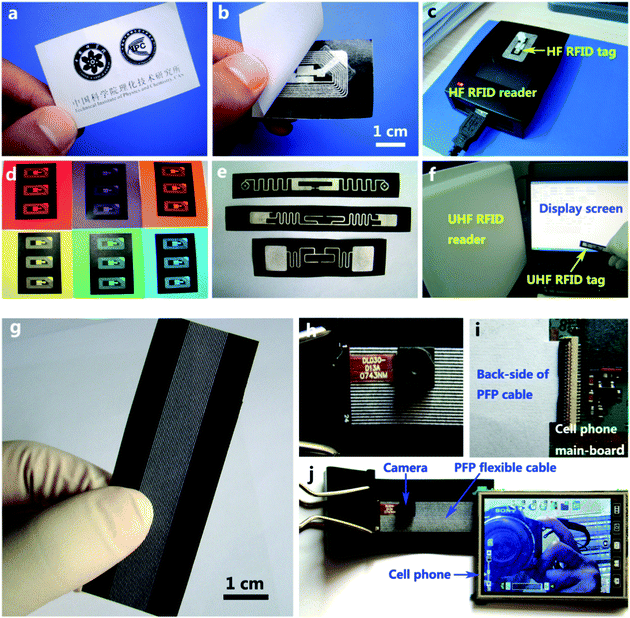A facile, green and efficient printing-filtration-press (PFP) technique is reported for room-temperature (RT) mass-production of low-cost, environmentally friendly, high performance paper-based electronic circuits. The as-prepared silver nanowires (Ag-NWs) are uniformly deposited at RT on a pre-printed paper substrate to form high quality circuits via vacuum filtration and pressing. The PFP circuit exhibits more excellent electrical property and bending stability compared with other flexible circuits made by existing techniques. Furthermore, practical applications of the PFP circuits are demonstrated.
Nanoscale,2014

(a) Schematic diagram of the printing-filtration-press technique: (i) negative pattern was printed on the paper substrate through screen printing, in which the orange colour represents the patterned screen before printing, (ii) Ag-NWs were deposited spontaneously along the designed pattern through the paper substrate as a filter by vacuum filtration, in which the black colour stands for the negative pattern made in (i), (iii) suitable pressure was applied on the circuit to densely compact the Ag-NW network against the paper substrate, and (iv) PVA solution was coated on the circuit for protection; (b) optical images of the printed substrates before (upper) and after (lower) Ag-NW deposition; (c) back-light mode optical microscopy images of different paper substrates (upper) and their images after screen printing (lower).

(a) SEM images of the as-synthesized silver nanowires, (b) digital photo of the Ag-NW ethanol solution, (c) the conductivity of the circuit versus the Ag-NW areal density at a fixed compaction pressure of 25 MPa and (d) SEM images for the surface morphology of the circuits with various Ag-NW areal densities.

(a) SEM images of the three paper-based Ag-NW circuits prepared using the PFP technique, the spray technique and the drop-casting technique, (b) the sheet resistance of the three paper-based Ag-NW circuits as a function of Ag-NW areal density, and (c) relative electrical resistance of the three paper-based Ag-NW circuits, the commercial etched copper circuit and the commercial conductive adhesive circuit as a function of the number of rolling cycles. The inset shows the rolling test system and the circuit samples and (d) SEM images of the surface morphologies respectively for the PFP circuit after 10[thin space (1/6-em)]000 rolling cycles and other circuits after a limited number of rolling cycles when they are broken.

(a) As-prepared high frequency (HF) RFID tag, (b) opened HF RFID tag, (c) a HF RFID tag is read with a commercial HF RFID reader, (d) colourful HF RFID antennas fabricated directly on various colour paper substrates, (e) ultrahigh frequency (UHF) RFID tags with various antenna patterns, (f) a UHF RFID tag is read with a commercial UHF RFID reader and the information recorded in the tag is shown on a display screen, (g) a PFP Ag-NW paper-based flexible cable with 24 circuits, (h) a micro-camera is connected to one end of the flexible cable, (i) another end of the cable is connected to the main-board of a cell phone, and (j) digital signals from the camera can be clearly transmitted to the cell phone through the flexible cable and the image is exhibited on the display screen of the cell phone.

